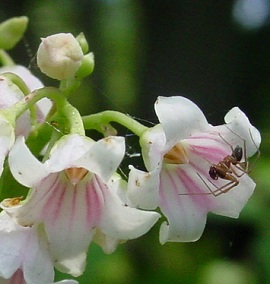
The leaves of Apocynum cannabinumgrow opposite from one another, and sometime three or more leaves grow in from one place.
Dogbane leaves are shaped like a spear-point, and have smooth edges. On the top the leaves are smooth and waxy, underneath they have downy white hairs.
Let us watch. Bees, flies, moths, and butterflies, especially the latter, hover near. Alighting, the butterfly visitor unrolls his long tongue and inserts it where the five pink veins tell him to, for five nectar-bearing glands stand in a ring around the base of the pistil. Now, as he with-draws his slender tongue through one of the V-shaped cavities that make a circle of traps, he may count himself lucky to escape with no heavier toll imposed than pollen cemented to it. This granular dust he is required to rub off against the stigma of the next flower entered. Some bees, too, have been taken with the dogbane's pollen cemented to their tongues.
But suppose a fly call upon this innocent-looking blossom? His short tongue, as well as the butterfly's, is guided into one of the V-shaped cavities after he has sipped; but, getting wedged between the trap's horny teeth, the poor little victim is held a prisoner there until he slowly dies of starvation in sight of plenty. This is the penalty he must pay for trespassing on the butterfly's preserves!
The dogbane, which is perfectly adapted to the butterfly, and dependent upon it for help in producing fertile seed, ruthlessly destroys all poachers that are not big or strong enough to jerk away from its vise-like grasp. One often sees small flies and even moths dead and dangling by the tongue from the wicked little charmers. If the flower assimilated their dead bodies as the pitcher plant, for example, does those of its victims, the fly's fate would seem less cruel. To be killed by slow torture and dangled like a scarecrow simply for pilfering a drop of nectar is surely an execution of justice medieval in its severity.
Very small white or yellowish white flowers are in clusters on the top.
The flowers are shaped like a cup in nature.
Dogbane lives in moist areas, along rivers or creeks, and may also be found in swampy areas such as ditches or fields that are being watered.
It can be found from New England to Texas and California.
The flowers appear in late spring throughout the summer, and are pollinated by small wasps, flies and bees.
A naturally occurring cardia stimulant, called cymarin can be found in the plants roots, and is listed in a medicinal text in an early pharmacopoeia from the forties and fifties in the US.
The sap can cause the skin to blister when it is directly applied to the skin.